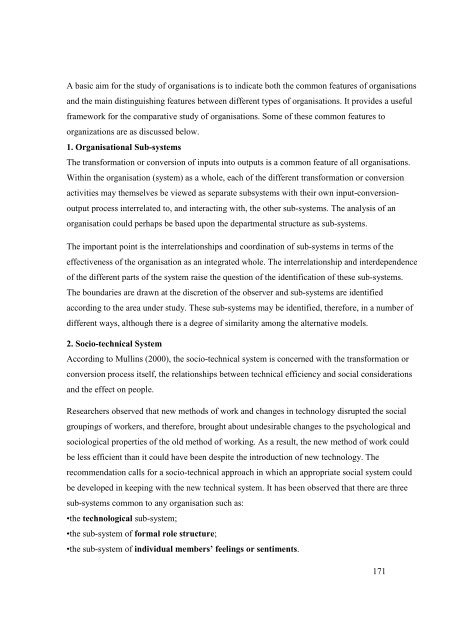HCM 433 MANGEMENT AND ORGANIZATIONAL BEHAVIOUR.pdf
HCM 433 MANGEMENT AND ORGANIZATIONAL BEHAVIOUR.pdf
HCM 433 MANGEMENT AND ORGANIZATIONAL BEHAVIOUR.pdf
Create successful ePaper yourself
Turn your PDF publications into a flip-book with our unique Google optimized e-Paper software.
A basic aim for the study of organisations is to indicate both the common features of organisations<br />
and the main distinguishing features between different types of organisations. It provides a useful<br />
framework for the comparative study of organisations. Some of these common features to<br />
organizations are as discussed below.<br />
1. Organisational Sub-systems<br />
The transformation or conversion of inputs into outputs is a common feature of all organisations.<br />
Within the organisation (system) as a whole, each of the different transformation or conversion<br />
activities may themselves be viewed as separate subsystems with their own input-conversionoutput<br />
process interrelated to, and interacting with, the other sub-systems. The analysis of an<br />
organisation could perhaps be based upon the departmental structure as sub-systems.<br />
The important point is the interrelationships and coordination of sub-systems in terms of the<br />
effectiveness of the organisation as an integrated whole. The interrelationship and interdependence<br />
of the different parts of the system raise the question of the identification of these sub-systems.<br />
The boundaries are drawn at the discretion of the observer and sub-systems are identified<br />
according to the area under study. These sub-systems may be identified, therefore, in a number of<br />
different ways, although there is a degree of similarity among the alternative models.<br />
2. Socio-technical System<br />
According to Mullins (2000), the socio-technical system is concerned with the transformation or<br />
conversion process itself, the relationships between technical efficiency and social considerations<br />
and the effect on people.<br />
Researchers observed that new methods of work and changes in technology disrupted the social<br />
groupings of workers, and therefore, brought about undesirable changes to the psychological and<br />
sociological properties of the old method of working. As a result, the new method of work could<br />
be less efficient than it could have been despite the introduction of new technology. The<br />
recommendation calls for a socio-technical approach in which an appropriate social system could<br />
be developed in keeping with the new technical system. It has been observed that there are three<br />
sub-systems common to any organisation such as:<br />
•the technological sub-system;<br />
•the sub-system of formal role structure;<br />
•the sub-system of individual members’ feelings or sentiments.<br />
171
















